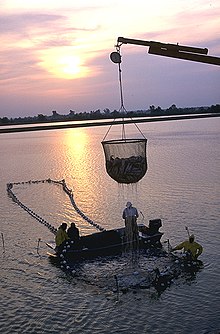Aquaculture
Aquaculture is the farming of fish, shrimp, abalones, algae, and other seafood. Aquaculture supplies fish, such as catfish, salmon, and trout. It was developed a few thousand years ago in China. Aquaculture supplies over 20% of all the seafood harvested.

Fish farming has been practiced, in some parts of the world, for thousands of years. Goldfish originated about a thousand years ago in carp farms in China, and the Roman Empire farmed oysters and other seafood. Today, half of the seafood eaten in the U.S. is farmed. To help meet the growing global demand for seafood, aquaculture is growing fast.[1]
The environmental impact of fish farming varies widely, depending on the species being farmed, the methods used and where the farm is located. When good practices are used, it's possible to farm seafood in a way that has very little impact to the environment. Such operations limit habitat damage, disease, escapes of farmed fish and the use of wild fish as feed.